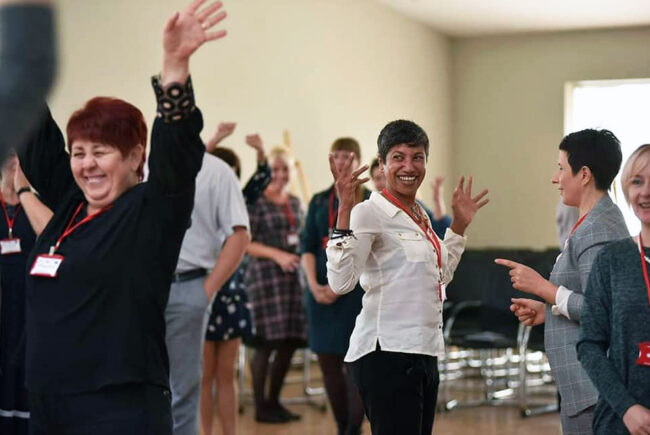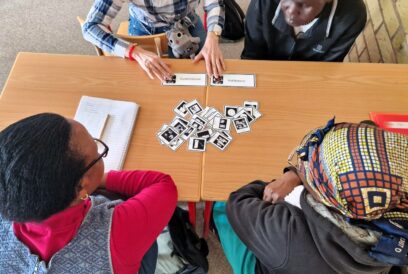

Pascale Mompoint-Gaillard (in the middle) lectures, writes and leads practitioners on topics such as experiential and transformative learning, leading systemic reflection and developing socially just learning ecologies. Photo: Pascale Mompoint-Gaillard
Pascale Mompoint-Gaillard (in the middle) lectures, writes and leads practitioners on topics such as experiential and transformative learning, leading systemic reflection and developing socially just learning ecologies. Photo: Pascale Mompoint-Gaillard
Pascale Mompoint-Gaillard’s research provides insights about supporting engagement, particularly in an online environment. Emotions really matter in engaging learning, she says.
In adult education and in education in general, people love to talk about learner engagement. How to engage more adults in learning? What are the best strategies for successful learner engagement?
Before diving into all of this, however, one could first examine what engagement actually means.
This is one of the questions Pascale Mompoint-Gaillard explored in her doctoral dissertation Conversation as an Ecology of Learning, which focused on the ways professionals develop through engaging in online professional learning communities.
In her work, Mompoint-Gaillard, a social psychologist, approaches engagement as a multidimensional idea.
“Engagement involves an interplay between emotional, cognitive, social and ethical dimensions. This idea is extremely useful when talking about adult learning and motivation,” Mompoint-Gaillard says.
Behavioural dimensions, for example, refer to sustaining engagement and not dropping out. Emotional dimensions encompass the quality of relations to peers and teachers, positive or negative reactions to tasks and the environment, and cognitive engagement means the willingness to do tasks.
Mompoint-Gaillard’s research provides insights about supporting engagement particularly in an online environment – useful for all educators. One of the key findings was that emotional elements of engagement were very heightened in online environments.
Online platform for continuous peer learning
Initially educated in social psychology, anthropology and sociology, Mompoint-Gaillard has worked in NGOs, higher education Institutions, ministries and international organisations such as the Council of Europe, UNESCO, the European Commission and several teacher education programmes.
Mompoint-Gaillard’s PhD topic stems from her work with the Pestalozzi programme and community.
Pascale Mompoint-Gaillard

- A social psychologist, trainer and facilitator, researcher.
- 2006-2017 worked as the Director of studies and Pedagogical Consultant for the Council of Europe Pestalozzi Programme for Education Professionals.
- CEO and co-founder of the NGO Learn to Change, Change to learn
The Pestalozzi Programme was the Council of Europe’s programme for professional development of teachers until the end of 2017 and, whilst working as the pedagogical consultant for the programme, Mompoint-Gaillard suggested creating an online platform for the teachers to continue learning together after participating in the programme’s training events.
In her eight-year role as the moderator of the platform, she closely followed the conversation between the educators.
“What pushed me into starting this research was the length of time the educators spent posting on the platform in their free time. I wanted to learn more about what motivated them to engage, given they were already very busy, and the platform did not lead to any credits.”
Participation is not always engagement
Defining her research questions and terms, Mompoint-Gaillard made a clear distinction between participation and engagement.
Participation can be both non-engagement and engagement and non-engagement is therefore a form of participation. Some people might not comment or actively share in the online conversation but still participate in it by reading, for example.
“Engagement, however, can be defined as interaction between a person and the environment, and this is what I wanted to study.”
Bringing human elements online includes sharing personal information about oneself – basically being real.
In her research, Mompoint-Gaillard analysed not only people’s posts but also patterns of interaction and activity on the platform. She found that cohesion really mattered – people responding to each other and no-one being ignored created successful engagement.
“Even if it was very short acknowledgement of someone’s post, it was important.”
In online environments, facilitators should focus on evoking curiosity, Mompoint-Gaillard claims. She found that as soon as there were “hooks” or something surprising, it made people come back to the platform.
“One the other hand, topical persistence is important. You can’t jump too much between different things in online learning,” she adds.
Being real matters online
Mompoint-Gaillard emphasises that educators need to invest in tending to the well-being of participants in online environments. Onboarding participants could involve, for example, starting the online session by learning something about each participant.
“Bringing human elements online includes sharing personal information about oneself – basically being real. This applies to the educator as well.”
The so-called peer presence of the facilitator can be very effective in creating engagement. At the same time, this makes the conversations more chaotic – people can freely comment, suggest topics and take the conversation in new, often surprising directions.
In her research Mompoint-Gaillard saw that increasing the chaotic element meant some people learning more and some people stopping engaging altogether.
“I think this is an important philosophical and political dilemma for all educators to think about. Do you want to facilitate some learning for everyone, more learning for others or less for some?”
From learners to activists
Mompoint-Gaillard says she has always been particularly interested in interaction between people, and the idea of collective intelligence.
“I believe in local communities and I believe in online communities. Change in education can be sluggish and often very much relies on the individual. Being a part of a community and talking to peers can be so important in creating a more communal spirit of change.”
In her research around the Pestalozzi community, Mompoint-Gaillard also wanted to find out how engagement on the platform impacted the educators’ practice. In what she now views as the most surprising finding in the study, she identified a new learner profile she called activist.
This is why professional learning communities are so important in creating change.
After following the conversation for years, Mompoint-Gaillard started to see how the teachers engaging were becoming increasingly critical of their education system, their practice and the policies around it. At the same time, they were shifting from the position of only delivering a certain curriculum to a position of having more autonomy in making decisions about what they wanted their practice to be.
“In essence, the process changed their professional identity. I found the slow emergence of an activist identity in teachers engaged in conversation on social justice. This is why professional learning communities are so important in creating change,” says Mompoint-Gaillard.
As an example, she shares one more observation from the Pestalozzi community. In their conversation on the platform, teachers came up with their own suggestions for making assessment more democratic.
When Mompoint-Gaillard compared the teachers’ ideas to expert recommendations on assessment made to the UK government (the Assessment Reform Group), she noticed teachers had, without knowing, developed the very same suggestions.
“In fact, they were going even further and coming up with ideas that had not been identified by the experts, including concerns of social justice and democracy in their reflection.”
Author







